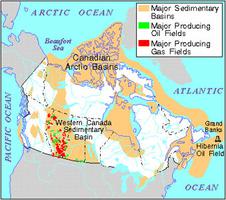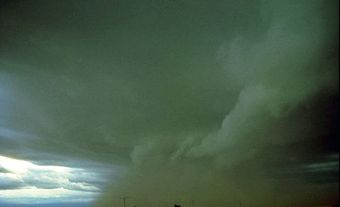Sedimentary Rock
Sedimentary rock, one of the 3 major classes of rock comprising the Earth's crust (the others being igneous and metamorphic), is made up of loose, unconsolidated sediment that has been transformed into rock (ie, lithified) during geological history.
Only about 5% of the Earth's crust is composed of sedimentary rocks, but they cover 70-75% of the exposed surface and contain many economically important minerals, as well as coal and petroleum. As exposed at the surface, the most important types by volume are shale 50%, sandstone 30% and limestone 20%. Calculations suggest that total surface plus subsurface proportions may be shale 79%, sandstone 13% and limestone 8%. Sedimentary rocks are classified by their mineral and chemical composition and by the source of the sediment. The 4 main classes are discussed below.
Terrigenous Rocks
Terrigenous rocks result from the erosion of older rocks, transport of the debris to the depositional site and slow lithification during geological time. Erosion produces particles of different sizes, and terrigenous rocks are classified by grain size. Shales are composed mostly of clay minerals smaller than 0.004 mm diameter. The plate-shaped clays allow shales to split easily into thin layers. Shales are prominent in the Cretaceous rocks of Alberta outcropping along the foothills of the Rockies, particularly the Blackstone and Wapiabi formations. Siltstones contain particles of 0.004-0.062 mm, with quartz grains and clays as the commonest particle types. Sandstones (particles 0.062-2 mm) are composed mostly of quartz and feldspar, weathered from older igneous and metamorphic rocks (or from pre-existing sandstones).
There are 3 main families of sandstones: orthoquartzites (90% of the sand-sized fraction, composed of quartz plus chert), arkoses (more than 25% feldspar grains); and greywackes (high proportion of muddy matrix and commonly more rock fragments than orthoquartzites and arkoses). Sandstones form the reservoir at Pembina, Alta, Canada's largest single oilfield. Conglomerates contain particles larger than 2 mm, ranging from small pebbles to boulders metres in diameter. Spaces between pebbles and boulders are usually filled with sand, silt and mud. Composition of the coarse fraction is varied, commonly with pebbles of pre-existing rocks such as granite, limestone, sandstone and basalt. Uranium deposits in the Elliot Lake area of Ontario are confined to conglomerate beds.
After deposition as loose sediment, the particles may become lithified. Individual particles can be cemented together by calcareous or siliceous cements deposited in pore spaces from percolating water. Particles can also be held together by materials that either were deposited with the larger particles or grew in the pore spaces during burial of the sediment.
Carbonate Rocks
Almost all particles in carbonate rocks are formed of the hard parts of marine organisms that lived close to the final depositional site. The main minerals are calcite, aragonite and dolomite. Aragonite precipitates most easily in warm water and maximum carbonate productivity occurs in shallow tropical seas. The particles commonly accumulate where they are formed, or may be swept by currents toward the shoreline or out into deeper water. Carbonate rocks consist of 3 basic types of material: discrete coarse grains; microcrystalline calcite ooze, called micrite; and sparry calcite cement. The discrete grains may be composed of algae and whole or broken skeletons of invertebrate animals.
Other grains, called pellets, are fecal in origin, consisting of rounded aggregates of carbonate mud excreted by mud-eating organisms. Ooliths are grains consisting of concentric layers of fine carbonate particles around a nucleus, commonly a skeletal fragment. The nucleus is rolled on the sea floor by strong currents and layers of inorganic precipitates are built up around it. Skeletal fragments, pellets and ooliths can clump together to form aggregates known as grapestones. All these particles can act as a surface for blue-green algae, which may coat them with a sticky layer that traps fine, carbonate sediment. The fine sediment micrite is mostly formed by calcareous algae. The algae contain minute aragonite needles that are released on death and accumulate as carbonate mud. Sparry calcite is an inorganically precipitated cement that grows in the pore spaces between discrete grains. It commonly forms from dissolved skeletal or micritic material, moved in solution by fluids in the pore spaces and reprecipitated as cement.
The naming of carbonate rocks derives from their composition and is based on the type of discrete grains and type of pore filling (micrite or sparry calcite). Thus a pelmicrite is composed of pellets with a micrite matrix, and an oosparite consists of ooliths with a sparry calcite cement. Carbonate rocks undergo mineralogical changes (diagenesis) during burial and lithification. For example, aragonite is frequently converted to calcite. The calcite grains are bound together as a result of the solution of some grains and the reprecipitation of the carbonate as cement, thus forming limestones. Spectacular examples dominate the scenery at Banff National Park; eg, the limestone cliffs of the Palliser and Rundle formations. The other major change involves conversion of calcite to dolomite, which takes place as pore waters enriched with magnesium percolate through the sediment. Dolomitization can take place molecule for molecule, preserving the textures of the original discrete grains. Alternatively, calcite can be dissolved and dolomite precipitated somewhat later, destroying the original texture. Dolomites with chert nodules form the hard capping layer of the Niagara Escarpment.
As well as the particulate rocks described above, there are massive limestones and dolomites built up by reef-building organisms such as corals. The immediate fore-reef area is commonly made up of a coarse-grained talus slope composed of broken blocks of the reef itself. Pore spaces in the reef or talus can remain open, or may fill with discrete grains, micrite or sparry calcite. Important examples include the reservoir rocks of the Leduc and Redwater oil fields in Alberta.
Chemical Rocks
Chemical rocks are composed of material that has been emplaced by a chemical process (eg, evaporation, precipitation). In volume, the most important chemical rocks are the evaporites, formed in hot, arid areas by the intense evaporation of seawater. The most important minerals formed are gypsum (converted to anhydrite on burial) and halite (common salt). Both gypsum and halite make up sequences of layered rocks, commonly associated with limestones and dolomites. The evaporite rocks of southern Saskatchewan form the basis of the potash mining industry.
Some bedded rocks are made up of microcrystalline or cryptocrystalline silica, termed chert. Many cherts, such as those now accumulating on the deep ocean floors, are made up of the hard parts of microscopic, silica-secreting organisms (radiolarians and diatoms). Some very ancient cherts are older than the oldest known siliceous organisms and may be chemical precipitates. An example of this formation occurs in the gunflint chert at Lake Superior.
Coal can also be considered a chemical rock, formed as a result of the accumulation of plant material and its transformation into peat and then coal. There is a progression or increase in "rank" (carbon and calorific content) from peat to lignite to subbituminous and bituminous coals and, finally, to anthracite. Anthracite is darkest in colour, containing the highest proportion of carbon and lowest amounts of moisture, volatile components and oxygen. Coal is economically important in BC, Alberta and the Maritimes.
Pyroclastic Rocks
Pyroclastic rocks are made up of volcanic-derived particles including bombs and blocks (larger than 64 mm), lapilli (or stones, 2-64 mm) and ash (finer than 2 mm). Most of the debris is transported through the air rather than by water. Pyroclastic rocks are termed agglomerates or volcanic breccias (bombs and blocks), lapilli tuffs or tuffs (mostly composed of ash). Welded tuffs contain fragments that were still hot when deposited from glowing avalanches (nuées ardentes); the deposits, called ignimbrites, may cover many hundred square kilometres.
Volcanic ejecta are classified compositionally as rock fragments, crystals or glass, the latter being small lumps of magma (molten rock) that cooled too quickly for development of specific minerals. Sequences of pyroclastic rocks can be thousands of metres thick; many examples occur in BC's Interior Plateau and on Vancouver Island. It has been estimated that in the last 400 years alone over 320 km3 of pyroclastic materials have been ejected from the world's volcanoes.

 Share on Facebook
Share on Facebook Share on X
Share on X Share by Email
Share by Email Share on Google Classroom
Share on Google Classroom





